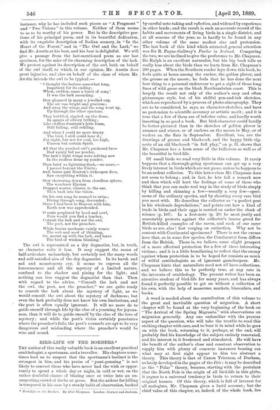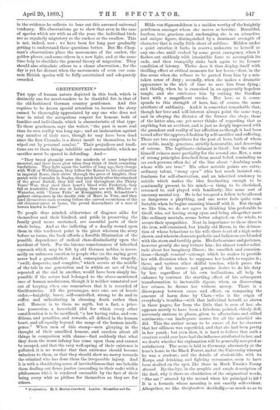BIRD-LIFE ON THE BORDERS.* TELE author of this really valuable
book is an excellent practical ornithologist, a sportsman, and a traveller. His chapters some- times lead us to suspect that the sportsman's instinct is the strongest in him, and his praise of " punt-gunning " is not likely to convert those who have never had the wish or oppor- tunity to spend a whole day or night, in cold or wet, on the rather doubtful chance of blazing once or twice into an un- suspecting crowd of ducks or geese. But the ardour for Ailing is tempered in his case by a steady habit of observation, backed
'Bird-Life on the Borders. By Abel Chapman. London : Gurney and Jackson.
by careful note-taking and reflection, and widened by experience in other lands ; and the result is such an accurate record of the habits and movements of living birds in a single district, and at all seasons of the year, as is hardly to be found in any other volume of the same modest size and pretension. The last book of this kind which attracted general attention was Sir R. Payne-Gallwey's Fowler in Ireland. Comparing the two, we are inclined to give the preference to Mr. Chapman. Sir Ralph is an excellent naturalist, but his big book tells us really less about the birds than we learn from Mr. Chapman's 280 pages. When the Southern reader lays down this book, he feels quite at home among the curlew, the golden plover, and the grouse on the moors; he feels that he has done the next best thing to a personal endeavour to get a sight of those long lines of wild geese on the bleak Northumbrian coast. This is largely the result not only of the author's easy and often picturesque style, but of his skilful pen-and-ink sketches, which are reproduced by a process of photo-zincography. They are to be considered, he says, as character-sketches, and have no pretension to scientific accuracy or artistic merit; and it is true that a few of them are of inferior value, and hardly worth inserting in so good a book. But bird-character could hardly be better pictured than in the sketches of golden plover in summer and winter, or of curlews on the moors in May, or of waders on the flats in September. Excellent, too, are the drawings of grouse and blackcock, and the happy little vig- nette of an old blackcock "in full play," on p. 31, shows that Mr. Chapman has a keen sense of the ludicrous as well as of the beautiful in bird-life.
Of small birds we read very little in this volume. It rarely happens that a thorough-going sportsman can get up a very lively interest in birds which are not game, unless he happens to be an ardent collector. To this latter class Mr. Chapman does not seem to belong ; and, in fact, he lets fall a remark now and then which will hurt the feelings of some of those who think that you can make real way in the study of birds simply by killing and skinning a few—usually a very few—speci- mens of the ordinary species, and by shooting every rare bird you meet with. He describes the collector as "a perfect pest in his wholesale depredations," and points out how a kind of trade in birds and their eggs is carried on under the cloak of science (p. 107). In a foot-note (p. 20) he most justly and seasonably protests against the collector's insane greed for British-killed examples of the raven, and such of our rarer birds as are, alas ! fast verging on extinction. Why not be content with Continental specimens P There is not the excuse here that, as in some few species, the Continental form differs from the British. There is, we believe, some slight prospect of a more effectual protection for a few of these interesting victims ; and it is a little humiliating to reflect that the enemy against whom protection is to be hoped for consists as ranch of wilful ornithologists as of ignorant gamekeepers. Mr. Chapman hints that naturalists need not all have collections, and we believe this to be perfectly true, at any rate in the interests of ornithology. The present writer has been an attentive student of bird-life for many years, and has always found it perfectly possible to get on without a collection of his own, with the help of museums, markets, binoculars, and books.
A word is needed about the contribution of this volume to the great and inevitable question of migration. A short chapter will be found at the very beginning of the book on "The Arrival of the Spring Migrants," with observations on migration generally. Any one unfamiliar with the present aspect of the question, who will take the trouble to read this striking chapter with care, and to bear it in mind while he goes on with the book, returning to it, perhaps, at the end, will probably find his knowledge of the subject entirely renovated, and his interest in it freshened and stimulated. He will have the benefit of the author's close and constant observation to supply him with plenty of concrete instances bearing out what may at first sight appear to him too abstract a theory. This theory is that of Canon Tristram, of Durham, as lately developed in the pages of the ibis; it may be described as the " Polar " theory, because, starting with the postulate that the North Pole is the origin of all bird-life in this globe, it argues to a universal tendency in birds to return to their original haunts. Of this theory, which is full of interest for all zoologists, Mr. Chapman gives a lucid account ; but the chief value of this chapter, as, indeed, of the whole book, lies in the evidence he collects to bear out this assumed universal tendency. His observations go to show that even in the case of species which are with us all the year, the individual birds are as regularly migratory as the cuckoo or the swallow. This is not, indeed, new ; we have been for long past gradually getting to understand these questions better. But Mr. Chap- man's observations place the movements of the curlew, the golden plover, and some others in a new light, and at the same time help to elucidate the general theory of migration. They should also stimulate others to a closer observation ; for the day is yet far distant when the movements of even our com- mon British species will be fully ascertained and adequately recorded.



































 Previous page
Previous page